I decided to try and use Jigspace. I put in some random things: a methane molecule; (my son had gas tonight); A Bolivian Flag (a place I really wantI decided to try and use Jigspace. I put in some random things: a methane molecule; (my son had gas tonight); A Bolivian Flag (a place I […]
I decided to try and use Jigspace. I put in some random things: a methane molecule; (my son had gas tonight); A Bolivian Flag (a place I really wantI decided to try and use Jigspace. I put in some random things: a methane molecule; (my son had gas tonight); A Bolivian Flag (a place I really want to visit.); A Liechtenstein (a place I have never heard of) and Surinam (where a cousin of mine lives) as well as the moon and venus. At first I found it kind of repetitive as I could only spin, move or change the colour of objects, but as I played around, I really liked different perspectives and how different everything was looking from above or from the angle of one of the objects. I also liked some of the objects, mainly the plants, coral, planets, food and furniture, and with out movements, you could use this to build mini sets and look from different angles. In my work, will I use this? I could use it to design instructions that require mapping a physical space. Maybe?


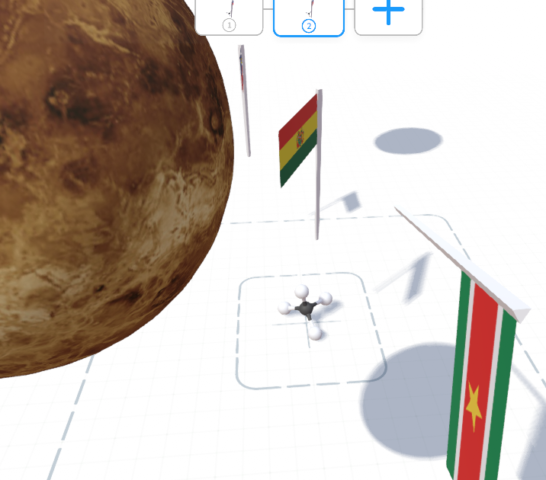

Sample Evaluation Question
In Teacher-made assessments: How to connect curriculum, instruction, and student learning (Gareis & Grant, 2015 p.70) they suggest that the best way to evaluate a student’s oral language skills is to have them give an oral presentation. They say this is more authentic than recalling answers about public speaking, but go on to say. “However, what […]
In Teacher-made assessments: How to connect curriculum, instruction, and student learning (Gareis & Grant, 2015 p.70) they suggest that the best way to evaluate a student’s oral language skills is to have them give an oral presentation. They say this is more authentic than recalling answers about public speaking, but go on to say. “However, what the teacher will gain in authenticity, will be lost in efficiency.”
On Jon Mueller’s website Authentic Assessment Toolbox http://jfmueller.faculty.noctrl.edu/toolbox/whatisit.htm he creates a dichotomy where traditional and authentic forms of evaluation are juxtaposed. An example would be, “Contrived vs. real life” or “Selecting a response vs. performing a task.”
Could we then say that traditional methods are more efficient than authentic methods? What is more efficient about using traditional methods? What lets us get a better picture of learning or knowledge: an authentic or traditional evaluation? What is authenticity in evaluation? Please discuss these questions and your interpretation of traditional and authentic evaluation as well as what constitutes efficiency in evaluation and efficiency of what? You have a 750 word limit.
I attended an event organized for the media to promote LECHOP. Have you heard of it? It is currently in its 4th year and to be honest, I had never heard of it. Similar to Le Happening Gourmand which is a group of restaurants from Old Montreal that get together and offer Table d’Hôte menus for $22, […]
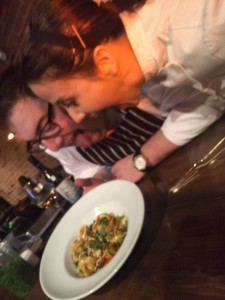
Chefs Machado and Sachet of L’Atelier d’Argentine and Newtown
I attended an event organized for the media to promote LECHOP. Have you heard of it? It is currently in its 4th year and to be honest, I had never heard of it. Similar to Le Happening Gourmand which is a group of restaurants from Old Montreal that get together and offer Table d’Hôte menus for $22, LeCHOP is like the downtown/crescent version. LECHOP’s Table d’hôte is $25 between January 4th and February 11th, but there is an added element as LECHOP has a weekly battle between the chefs of their respective restaurants using a featured ingredient and their battle dish is then served exclusively that week.
When I was first asked to attend I thought, hmmm… Newtown, L’Atelier d’Argentine, Weinstein & Gavino’s and Decca 77. I’m not really one of those downtown or crescent kind of diners. I had been to L’Atelier d’Argentine twice and greatly appreciated the decor but was gravely disappointed by the food and how much I paid for it and to see how packed the place was despite the food’s poor performance. I’ve always felt that these types of establishments were built more on strong marketing teams than on culinary talent. Decca 77, however, I knew there was a bit more to them from a culinary point of view, so it piqued my interest. The event was supposed to be hosted by Alexandre Despatis who hosts the LECHOP show which is also a common marketing strategy of getting a prominent public figure to be at the front center of your activity, but then I guess Crudessence was using Georges Laraque for awhile as a vegan spokesperson. My curiosity got the better of me and I went with good friend Tania Jimenez.
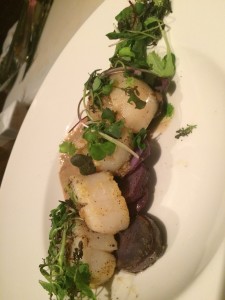
Featured ingredient of the week was scallops; Callos de Chubut de
The welcome was warm and I saw the chefs doing their best to put on a show out in the crowd while the action actually was in the kitchen behind the scenes. It’s not all chefs that are willing to get out of the kitchen to please and smooze with the crowd. Natalia Machado of l’Atelier d’Argentine (also a lady chef) Paulo Fraga of Weinstein & Gavino’s and Giuseppe Sachetti were the most gregarious as I imagine that Jean-Sébastien Giguère of Decca 77 was in the kitchen. After showing us the last LECHOP episode, for which people could go and vote online for their favourite dish/chef, then came the canapés along with the free-flowing wine. There were bites of peppery venison with berry jelly, canapés of pancetta and cream, beet and goat’s cheese saiad all of which were good, but one really caught my palette made by Jean-Sébastien Giguère of Decca 77. This was a smoked salmon mousse with sake candied shallots, maple mayo, furikake (seaweed) and anise powder. It was worth it to come out for this bite.
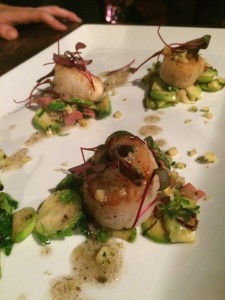
More scallops, quite elegant
I guess the moral of the story is that there are over 6000 restaurants in Montreal, the most per capital in North America, yet we are probably the coldest major urban centre in North America as well. Excluding the Toqués (who even almost went under) and Pied de Cochons and a handful of other restaurants in Montreal, most have to think up ways to keep their sales figures up in the months that tourists are MIA and Montrealers are cocooning. I admire the zest of the event and pushing the chefs to create weekly and to prove themselves but mostly getting the public involved through a voting system and through Table d’hôte prices that make it a small gamble to come out and eat or try something new for the client. Some of the restaurants with superstar chefs in Montreal smugly say that they don’t advertise, yet some of that arrogance has led them to open one too many restaurants without verifying the solidity of their concept, the staff or menu or maintain the quality of their initial first “baby”. I have to say, I enjoyed going to an event where the chefs didn’t seem to take themselves too seriously and I also take my hat off to those that put themselves out there and invite bloggers or journalists or other food business people to see what they are doing. Nothing ventured, nothing gained. That’s how you reach new markets and not by staying inside of your cliqua until it cannobalizes itself. It was a reminder that you may be stronger collaborating and levereging with others in the food industry than staying atop your lonesome peak either sitting on your laurels or lamenting how tough the industry is in Montreal. This was also a reminder to me that at those moments when business is tough, it’s the moment to innovate and get out in the world, even if that’s the last thing you feel like at that moment. It’s also good for people writing to get out of what they think they are about and try some new things or different approaches and see how impartial they can be!
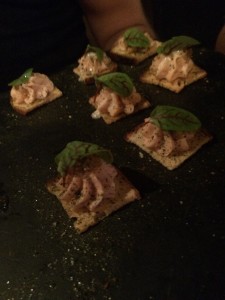
Jean-Sébastien Giguère”s super smoked salmon bouchée
CATEGORIES
Archives
- February 2022 (1)
- October 2020 (2)
- September 2020 (1)
- January 2016 (1)
- January 2015 (1)
- October 2014 (1)
- February 2014 (1)
- January 2014 (1)
- July 2013 (1)
- June 2013 (2)
- May 2013 (1)
- March 2013 (1)
- February 2013 (2)
- November 2012 (1)
- September 2012 (1)
- June 2012 (2)
- May 2012 (1)
- April 2012 (1)
- March 2012 (1)
- February 2012 (1)
- January 2012 (2)
- December 2011 (1)
- November 2011 (4)
- October 2011 (4)
Popular Tags
'Round Table Tours Asian breakfast business prolfiles cabbage canning Community Europe Events farms fermentation Fitz & Follwell Food & Story Food history Food Production food tours fresh juices Friends gastronomy health herbs History Italy kimchi Meal exchange Nuart organic preserves public Quebec restaurant Rumble & Shakes Réseau d`Entraide de Verdun salt smoothies spicy Tours de la Table Vegan youtube videos

